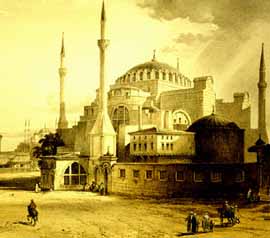- Glass Making in Roman Times
- Roman Wine: A Window on an Ancient Economy
- Roman Wine: Windows on a Lifestyle
- Fine Glassware in the Roman World
- Reuse of Images in the Art of Rogier van der Weyden
Ecclesiastical Lighting

Church of the Holy Wisdom, Constantinople
1835 engraving by David Roberts
In hindsight, we can recognize what an enlightened decision that was. No sooner was Constantinople dedicated in A.D. 330, than the process began of filling it with fine churches. By the mid-5th century A.D., there were at least fourteen of them, all mixed in with eleven massive palaces of emperors and empresses.
The Byzantine era was a period in which Roman glassworking reorganized itself in a way that was almost as dramatic as the changes which occurred in Augustan times. This was to be the age of the lamp-maker: so much so that fragments of lamps dominate the glassware recovered by archaeologists from trash-pits in early Byzantine urban contexts.
Constantine's version of the Church of Holy Wisdom was destroyed during political riots in A.D. 532. But it was re-built and re-consecrated just five years later, and its new-found magnificence prompted the emperor Justinian to declare, "Solomon, I have surpassed you!" The central lighting fixtures of the Church may well have held more than a thousand glass lamps, clustered in a set of concentric supporting frames.
